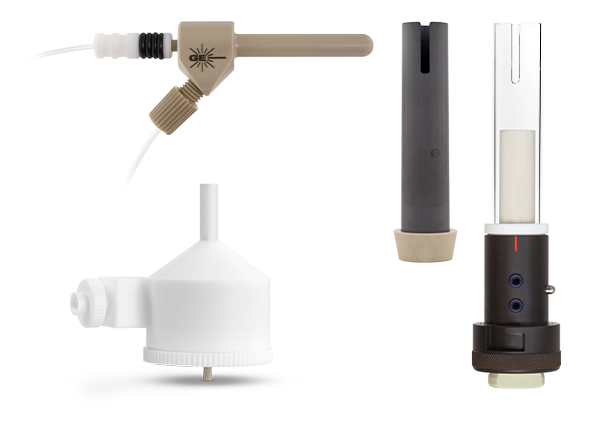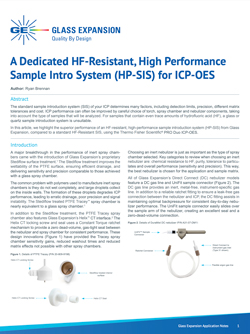Abstract
The standard sample introduction system (SIS) of your ICP determines many factors, including detection limits, precision, different matrix tolerances and cost. ICP performance can often be improved by careful choice of torch, spray chamber and nebulizer components, taking into account the type of samples that will be analyzed. For samples that contain even trace amounts of hydrofluoric acid (HF), a glass or quartz sample introduction system is unsuitable.
In this article, we highlight the superior performance of an HF-resistant, high-performance sample introduction system (HP-SIS) from Glass Expansion, compared to a standard HF-Resistant SIS, using the Thermo Scientific™ PRO Duo ICP-OES.
Introduction
A major breakthrough in the performance of inert spray chambers came with the introduction of Glass Expansion’s proprietary Stediflow surface treatment. The Stediflow treatment improves the wettability of the PTFE surface, ensuring efficient drainage, and delivering sensitivity and precision comparable to those achieved with a glass spray chamber.
The common problem with polymers used to manufacture inert spray chambers is they do not wet completely, and large droplets collect on the inside walls. The formation of these droplets degrades ICP performance, leading to erratic drainage, poor precision and signal instability. The Stediflow treated PTFE Tracey™ spray chamber is nearly equivalent to a glass spray chamber.
In addition to the Stediflow treatment, the PTFE Tracey spray chamber also features Glass Expansion’s Helix™ CT interface. The Helix CT locking screw and seal uses a Constant Torque ratchet mechanism to provide a zero dead-volume, gas-tight seal between the nebulizer and spray chamber for consistent performance. These design innovations (Figure 1) have provided the Tracey spray chamber sensitivity gains, reduced washout times and reduced matrix effects not possible with other spray chambers.

Choosing an inert nebulizer is just as important as the type of spray chamber selected. Key categories to review when choosing an inert nebulizer are: chemical resistance to HF, purity, tolerance to particulates and overall performance (sensitivity and precision). This way, the best nebulizer is chosen for the application and sample matrix.
All of Glass Expansion’s Direct Connect (DC) nebulizer models feature a DC gas line and UniFit sample connector (Figure 2). The DC gas line provides an inert, metal-free, instrument-specific gas line. In addition to a reliable ratchet fitting to ensure a leak-free gas connection between the nebulizer and ICP, the DC fitting assists in maintaining optimal backpressure for consistent day-to-day nebulizer performance. The UniFit sample connector easily slides over the sample arm of the nebulizer, creating an excellent seal and a zero-dead-volume connection.
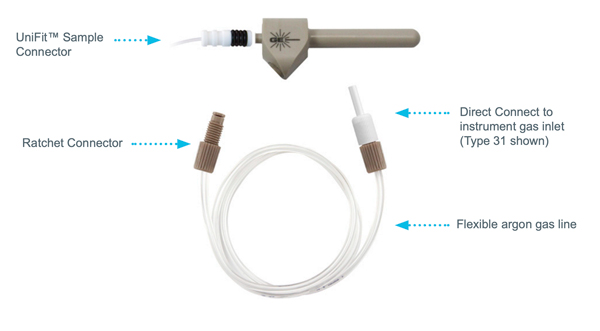
Glass Expansion’s DuraMist™ DC nebulizer is made from PEEK and is the most economical HF-resistant nebulizer for high-precision analysis. It is highly sensitive, with excellent short-term precision and the highest tolerance to dissolved solids (up to 30% TDS) of any concentric nebulizer.
The DuraMist DC nebulizer is a great “all-rounder” and ideal for high-throughput labs that require a good balance between durability and sensitivity. Serviceability is high, as the capillary insert can be replaced if needed.
The ICP-OES torch is typically the most often replaced and a higher annual consumable cost for laboratories with complex matrices, like HF. Many ICP-OES manufacturers have moved away from a single-piece torch to a demountable torch for this reason. Glass Expansion designed and patented the D-Torch™ (Figure 3), a precision-engineered demountable torch. Compared to other designs, the D-Torch is the only design with a ceramic intermediate tube and demountable ceramic outer tube.
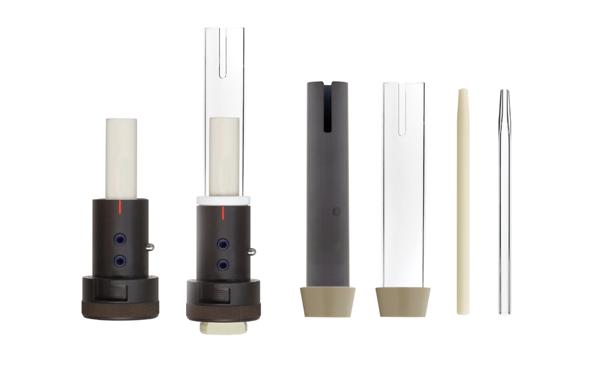
Glass Expansion pioneered the design of ceramic torches more than 20 years ago. Using a ceramic outer tube on your ICP torch produces a hotter, more robust plasma, which reduces matrix effects and improves detection limits. Compared to a quartz outer tube, the ceramic outer tube has a much longer lifetime, greatly reducing maintenance and downtime due to torch failure. Today, a fully ceramic D-Torch is available for a wide range of ICP models, including Agilent®, PerkinElmer®, Spectro™ and Thermo Scientific™.
Experimental
The Glass Expansion configuration consisted of the DuraMist™ nebulizer (P/N A31-07-DM1) coupled with the PTFE Tracey™ spray chamber (P/N 20-809-9198) and fully ceramic D-Torch™ (P/N 30- 808-4150 and 31-808-3996) with a 2.0mm ID alumina injector (P/N 31-808-2835). An evaluation of the relative sensitivity and relative signal-to-root background ratio (SRBR) was used to compare the performance of Glass Expansion’s HF-resistant HP-SIS to the standard HF-Resistant SIS.
All experiments were conducted under identical conditions using a Thermo Scientific™ PRO Duo ICP-OES. Instrumental conditions are listed in Table I. Two solutions were prepared: a 2% HNO3 blank and multi-element standard in 2% HNO3 consisting of 10ppm As and Se; and 5ppm Cu, K, Mg, Mn, Na and Ni.
| Name | Set Value |
| RF Power | 1200 W |
| Nebulizer gas flow rate | 0.70 L/min |
| Auxiliary gas flow rate | 1.00 L/min |
| Plasma gas flow rate | 12.0 L/min |
| Read time | 30 sec |
| Replicates | 3 |
| Viewing mode | Axial |
| Sample pump tubing | 0.64mm ID (Orange/White) P/N: 0.64-OW-F |
| Drain pump tubing | 1.02mm ID (White/White) P/N: 1.02-WHT-F |
| Peristaltic pump speed | 45 rpm |
Results
The Glass Expansion configuration consisted of the DuraMist™ nebulizer (P/N A31-07-DM1) coupled with the PTFE Tracey™ spray chamber (P/N 20-809-9198) and fully ceramic D-Torch™ (P/N 30- 808-4150 and 31-808-3996) with a 2.0mm ID alumina injector (P/N 31-808-2835). An evaluation of the relative sensitivity and relative signal-to-root background ratio (SRBR) was used to compare the performance of Glass Expansion’s HF-resistant HP-SIS to the standard HF-Resistant SIS.
The best indicator of analytical detectability for ICP-OES using a solid-state detector is the SRBR. Similar to what was observed when comparing sensitivity, the DuraMist™ nebulizer, PTFE Tracey™ spray chamber and fully ceramic D-Torch™ provide a 40% average improvement in SRBR over the standard HF-resistant SIS (Figure 5).
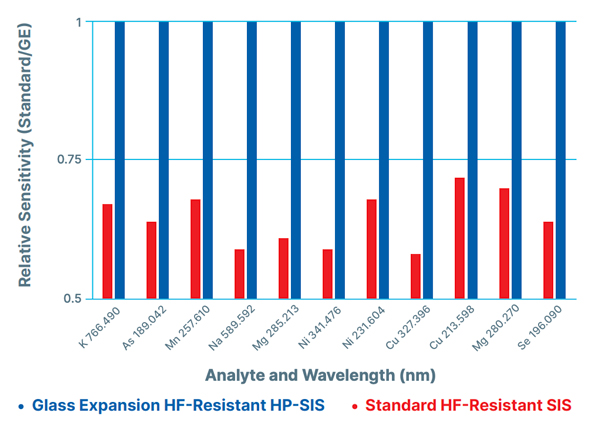
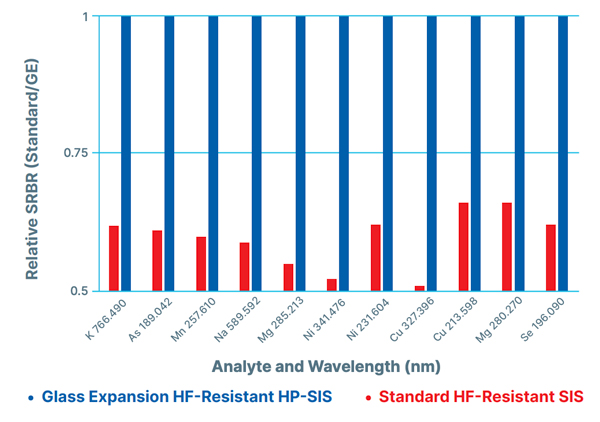
Conclusion
The results presented in this report indicate that sensitivity and SRBR are both improved by an average of 35% and 40%, respectively, with the Glass Expansion HF-resistant HP-SIS. The combination of the DuraMist™, PTFE Tracey™ and ceramic D-Torch™ is the superior inert sample introduction configuration compared to the standard HF-Resistant SIS.
References
- Glass Expansion Newsletter, February 2006, Improving the Performance of ICP Spectrometers.
- Glass Expansion Newsletter, February 2018, Helix CT ICP Spray Chamber with ConstantTorque Technology Provides Consistent Day-to-Day Analytical Performance.
- Glass Expansion Newsletter, May 2019, A Guide to Choosing Nebulizers and Spray Chambers for your ICP-OES.
